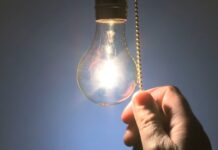When it comes to lamps, we usually think about the lightbulb. But what about the rest of the lamp? The base, the arm, and the shade? What do they do, and what are their parts?
In this blog post, we’ll take a closer look at Parts Of Fluorescent Lamp And Its Function. We’ll also discuss what each part does and how it functions. So if you’re curious about fluorescent lamps, read on!
What Is Fluorescent Lamp:
A fluorescent lamp, also known as a tube light or a fluorescent tube, is a type of electric lighting that uses mercury vapor to produce bright white light.
It commonly comes in the form of two glass tubes arranged end-to-end, with low-pressure gas inside and an electrode at each end.
Parts Of Fluorescent Lamp And Its Function:
The parts of fluorescent lamp and its function are very simple and easy to explain. Let’s take a look at each part and its function.
1. The Base:
The base of a fluorescent lamp is the part that screws into the socket. It also helps to support the weight of the lamp and keep it steady.
2. The Arm:
The arm is the part of the lamp that connects the base to the shade. It helps to support the weight of the shade and contains the gas and electrified electrodes inside.
3. The Shade:
The shade is the part of the lamp that houses the tube light. It helps to shield the glowing lamp from view, while also diffusing its bright light for a pleasant glow.
4. The Tube Light:
The tube light is the part of the lamp that contains mercury vapor and produces bright white light. It is sealed at both ends and contains an electrode at each end.
5. The Electrodes:
The electrodes are the parts of the lamp that provide electrical current to the mercury vapor inside the tube light. They are made of tungsten and are located at the ends of the tube light.
6. The Starter:
The starter is the part of the lamp that provides a burst of electrical current to the electrodes when you first turn on the light. It sparks and ignites the mercury vapor inside, allowing the lamp to produce light.
7. The Ballast:
The ballast is the part of the lamp that regulates the flow of electrical current to the tube light. It helps to prevent the lamp from flickering or going out.
8. The Reflector:
The reflector is the part of the lamp that helps to reflect and direct the light produced by the tube light. It is usually made of aluminum or another reflective material.
Now that you know the parts of fluorescent lamps and their function, you can better understand how this type of electric lighting works.
How Fluorescent Lamp Work:
Fluorescent lamps work by using mercury vapor to produce light. When an electrical current is applied to the electrodes at the ends of the tube light, it causes a spark that ignites the mercury vapor inside.
This reaction produces ultraviolet light, which is then converted into visible light by the phosphor coating on the inside of the tube light.
The reflector helps to reflect and direct the light produced by the tube light, while the shade diffuses it for a more pleasant glow.
Advantages Of Using Fluorescent Lamp:
There are many advantages to using fluorescent lamps, including the following:
1. Produce Bright Light:
One of the biggest advantages of using fluorescent lamps is that they produce bright light. This makes them great for use in areas where you need a lot of light, such as offices, kitchens, and garages.
2. Save Energy:
Another big advantage of using fluorescent lamps is that they are very energy-efficient. They use less energy than incandescent bulbs, which means that they can help you to save on your energy costs.
3. Long Lifespan:
Fluorescent lamps also have a much longer lifespan than incandescent bulbs, typically lasting several times longer. This makes them an excellent choice for areas where you need lighting that is reliable and consistent.
4. Reduce Lighting Costs:
Because fluorescent lamps are so energy-efficient, they can help you to reduce your lighting costs. This is especially true if you replace all of the incandescent bulbs in your home with fluorescent lamps.
Disadvantages Of Using Fluorescent Lamp
While there are many advantages to using fluorescent lamps, there are also some disadvantages that you should be aware of.
1. Toxicity:
One of the biggest disadvantages of using fluorescent lamps is that they contain mercury vapor, which is a toxic substance. If a fluorescent lamp breaks, it can release mercury vapor into the air, which can be harmful to your health.
2. Flickering:
Another disadvantage of using fluorescent lamps is that they can sometimes flicker or buzz. This can be annoying and disruptive, and it can also cause headaches in some people.
3. Not Disposable:
Because fluorescent lamps contain mercury, they are not able to be disposed of in the regular trash. Instead, you must take them to a special facility for recycling.
Conclusion:
Fluorescent lamps are an important part of many people’s lives, and it is important to understand how they work in order to get the most out of them. Students especially should be aware of the different parts of a fluorescent lamp and its function.
We hope this article has been helpful in educating you about fluorescent lamps. Are there any other questions you have about these lamps? Let us know, and we would be happy to answer them.
FAQs:
1. How is a fluorescent lamp more efficient than other types of lamps?
Answer: Fluorescent lamps are more efficient than other types of lamps because they use less energy to create the same amount of light. For example, a 60-watt fluorescent lamp produces as much light as a 100-watt incandescent lamp.
2. Do all fluorescent lamps have the same parts?
Answer: Not all fluorescent lamps have the same parts. Different types of fluorescent lamps are designed for different purposes, and so they may have different numbers and types of parts.
3. Can I replace the fluorescent lamps part on my own?
Answer: Lamp users or students should not replace the fluorescent lamps by themselves. It is a more complex process than it seems, and an improper installation can lead to decreased lamp life and other problems.



